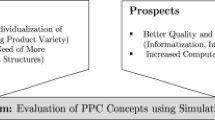Abstract
New production concepts rely on the active (co-) shaping of planning, control and organisation processes on the shop floor level. Established CAPM technologies (CAPM =Computer Aided Production Management) only provide insufficient support, and a complete automation of the production management is not suited to close this gap. This is why new principles of system design have to be developed which meet various requirements: from taking into account a multidimensionality and contradiction of planning targets and the integration of learning opportunities with the use of systems up to the promotion of work process knowledge.
Similar content being viewed by others
References
Benckert, H., Fischer, M. and Römmermann, E. (1996). The Design of Technical Artifacts with Regard to Work Experience. The Development of an Experience-based Documentation System for Maintenance Workers. In: Binder, Th., Fischer, M. and Nilsson, J. (eds.). Learning with artifacts.Special issue of AI & Society. Springer, London.10(1), 1–5.
Binder, Th. (1995). Designing for Work Place Learning — Stimulating new learning opportunities and learning practices on the shop floor through participatory design of Multimedia based learning materials. Danish Technological Institute, Taastrup.
Brown, D. E. and Scherer, W. T. (eds) (1995). Intelligent scheduling systems. Boston, Kluwer.
Bullinger, H.-J., Bamberger, R. und Hofmann, A. (1995). Auswahl und Einführung von Leitständen. In:CIM Management 11 (1995) 1.
Cooley, M. (1987). Architect or bee? The human price of technology. Revised edition. London: The Hogarth Press.
Corbett, J. M., Rasmussen, L. B. and Rauner, F. (1991). Crossing the Border. The Social and Engineering Design of Computer Integrated Manufacturing Systems. London, Springer.
Duffy, Th. M., Mehlenacher, B. and Palmer, J. E. (1992). Online Help: Design and Evaluation. Ablex Publishing, Norwood.
Eisenberg, M. and Fischer, G. (1994). Programmable Design Environments: Integrating End-User Programming with Domain-Oriented Assistance. In: CHI '94 Conference Proceedings: Human Factors in Computing Systems. Amsterdam, Addison Wesley.
Fischer, G. (1995a). New Perspectives on Working, Learning and Collaborating and Computational Artifacts in Their Support. In: H.-D. Böcker (Hg.): Software Ergonomie '95. Mensch-Computer-Interaktion, Anwendungsbereiche lernen voneinander Teubner, Stuttgart.
Fischer, G. (1995b). Learning Opportunities Provided by Domain-Oriented Design Enviroments. In: diSessa, A. A., Hoyles, C., Noss, R. (eds).Computers and Exploratory Learning. Computer and Systems Sciences, Vol. 146. Springer, Berlin.
Fischer, M., Jungeblut, R. und Römmermann, E. (1995). “Jede Maschine hat ihre eigenen Marotten!” Instandhaltungsarbeit in der rechnergestützten Produktion und Möglichkeiten technischer Unterstützung. Donat, Bremen.
Fischer, M. (1996). Überlegungen zu einem arbeitspädagogischen und-psychologischen Erfahrungsbegriff. In:ZBW 92 (1996)3.
Graves, R. J., Konopka, J. M. and Milne, R. J. (1995). Literature review of material flow control mechanisms. In:Production Planning and Control 6 (1995) 5.
Hamburg, I. and Paul, Hj. (1993). Beispiele für arbeitsorientierte Benutzungsoberflächen von DV-Systemen für Ingenieuraufgaben. In: Konradt, U. und Drisis, L. (Hg.): Software-Ergonomie in der Gruppenarbeit. Leske + Budrich, Opladen.
Heeg, F. J. (1995). Erfordernisse zur Gestaltung und Einführung innovativer DV-Systeme in der werkstattnahen Produktion. In: Heeg, F. J., Hirsch, B. E. (Hg:): Effektiver EDV-Einsatz in der werkstattnahen Produktion. Bremer Schriften zu Betriebstechnik und Arbeitswissenschaft. Mainz, Aachen.
Kosturiak, J. and Gregor, M. (1995). Total production control. In:Production Planning and Control 6 (1995) 6.
Kruse, W. (1985). Ausbildungsqualität, Arbeitsprozeß-Wissen und soziotechnische Grundbildung. In: Gewerkschaftliche Bildungspolitik 5/1985.
Moldaschl, M. und Schultz-Wild, R. (Hg.) (1994). Arbeitsorientierte Rationalisierung. Fertigungsinseln und Gruppenarbeit im Maschinenbau. Campus, Ffm.
Nedeß, Ch., Mallon, J. und Strosina, Ch. (1995). Die neue Fabrik. Handlungsleitfaden zur Gestaltung integrierter Produktionsstrukturen. Springer, Berlin.
Projektträger Arbeit and Technik (Hg.) (1994). Leitstände für die Werkstattsteuerung. Ergebnisse des Verbundprojektes PLANLEIT. Wirtschaftsverlag, Bremerhaven.
Rauner, F. und Spöttl, G. (1995). Berufliche Bildung und betriebliche Innovation als Moment des europäischen Strukturwandels, diskutiert am Beispiel der FORCE-Sektorstudie zum Kfz-Gewerbe. In: Dybowski, G., Pütz, H. und Rauner, F. (Hg.).Berufsbildung und Organisationsentwicklung. Bremen: Donat.
Scheer, A.-W., Nüttgens, M. und Zimmermann, V. (1995). Rahmenkonzept für ein integriertes Geschäftsprozeßmanagement. In:WI-Wirtschaftsinformatik 37 (1995) 5.
Schultz, J., Weigelt, M. und Mertens, P. (1995). Verfahren für die rechnergestützte Produktionsfeinplanung. In:WI-Wirtschaftsinformatik 37 (1995) 6.
Singh K., Schneider, B. and Kurbel, K., (1995). Solving Sequencing Problems Using Recurrent Neural Networks and Simulated Annealing — A Structural and Computational Comparison. In: Derigs, U., Bachem, A., Drexl, A. (Hg.) (1995).Operations Research Proceedings 1994. Springer.
Stuber, F. (1997). Rechnerunterstützung für arbeitsprozeßnahes Planen. Software-Innovation im Kontext von ÷konomie.Organisation und beruflicher Bildung. Bremen: Donat.
Ulich, E., (1993). Von der Benutzungsoberfläche zur Arbeitsgestaltung. In: Rödiger, K.-H. (Hg.): Software-Ergonomie '93. Von der Benutzungsoberfläche zur Arbeitsgestaltung. German Chapter of the ACM, Berichte39. Teubner, Stuttgart.
Warnecke, H.-J. (1993). Revolution der Unternehmenskultur. Das Fraktale Unternehmen. 2. Auflage. Springer, Berlin.
Author information
Authors and Affiliations
Corresponding author
Rights and permissions
About this article
Cite this article
Stuber, F. Planning and scheduling in new computer supported production contexts. AI & Soc 12, 239–250 (1998). https://doi.org/10.1007/BF01179797
Issue Date:
DOI: https://doi.org/10.1007/BF01179797




